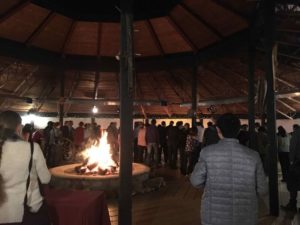Flora Weissgerber (Postdoctoral Researcher, Edinburgh), 10 April 2017
The First North American CryoSat science meeting was held in Banff, Alberta Canada from the 20th to the 24th March 2017 in parallel with the Fourth Swarm meeting.
Coming from a side-looking SAR/signal processing background, this conference was my first one in the altimetry and cryosphere communities. It was the occasion when I discovered with amazement the fifty shades of ice and snow as well as the diversity of CryoSat-2 applications.
ESA’s choice of location was better than I first expected after seeing the size of the city on google maps. Despite being a bit far from an international airport, the town of Banff has several assets. Nested in the Canadian Rockies, Banff provides ski resorts, hikes, hot springs or various historic monuments to delight visitors, not to mention the wonderful views on snowy mountains that put everyone in a good mood.

Banff from the Tunnel Mountain

White mountains and blue sky at the door, what more can you ask for?
The conference was hosted by the Banff Park Lodge Hotel, which offers adjustable and comfortable conference rooms, with efficient technical support. The hotel also provided nice food three times a day (offered by ESA), enabling us to carry easily on discussions after the sessions. The social event was the occasion to discuss and relax around a big fireplace, and to learn few line dancing steps!

Lunch is ready

Line dancing in front of the fire
Despite all the temptations offered by Banff and its surroundings, the sessions were crowded and animated, with high quality talks providing the science exchanges expected by all the participants.
The opening talks were the occasion to discover interactions between scientists and citizen scientists around Aurora Borealis research, to be reassured about the future of Earth Observation at Nasa, and to understand better the link between the ESA Earth Explorer Missions and the funding of ESA missions.
“The future looks bright for humanity and OK for the Earth Observation division of NASA.”
Michael Freilich, Director NASA Earth Science Division
In the sea ice sessions, I learned about the imbrication between the ice freeboard and snow load measurements, as well as the precision required to perform an evaluation of the sea ice mass balance. With ice sheets, the combination of different data sets and data from different sensors seems key to improving the quality and increasing the time coverage of elevation measurements. As an ice novice, I was amazed at the multitude of dynamic processes in glaciers and ice caps: sub glacial lakes and drainage, crevasses formations and movements, and so on.
Descriptions of field experiments always gave wonderful pictures and epic stories, as well as advances in the understanding of the ice dynamic or mass changes.
The follow-on from the CryoSat-2 mission was a hot topic among the many subjects discussed. The good news is that CryoSat-2 is in good health and some dreams of an overlap with a follow-on mission were entertained. This overlap would allow a cross-calibration phase to maintain long-term time-series of data. Any CryoSat follow-on is likely to be a dual frequency Ku-Ka SAR sensor, with interferometric possibilities in Ku. The dual frequency should help to resolve the snow problem over sea ice: the Ka band penetrating less than the Ku one. Studies over ice sheets are underway, but there is no assurance of a follow-on yet: the finance cycle of ESA by the member states will start in 2019.
Another way to overcome the snow problem would be to change the orbit of CryoSat-2 mission, to increase the co-occurrence of IceSat-2 and CryoSat-2 acquisitions (when the satellite IceSat-2 is launched). The new CryoSat-2 orbit has not been fully decided, but this would lead to a lower repeat time since IceSat-2 is meant to be a repeat pass satellite and not a drifting one such as CryoSat-2. But maintaining the satellite in this new orbit would necessarily consume more fuel and could diminish the acquisition time since the instruments are turned off for the orbital manoeuvre. Overall, this could reduce the lifespan of CryoSat-2, which could be disastrous if the follow-on is not planned, conceived, built, launched and successfully orbited soon enough.
All these modifications could affect the data continuity necessary to build long time series and analyze long-term trends. Another change that could impact this directly is the suppression of the LRM mode in the CryoSat-2 follow-on, which would improve the resolution of the acquired data. If the present satellite only cannot acquire data in SAR and SARIn mode due to energy capacity, the follow-on could be designed to overcome this technical issue. In order not to lose the long time series capacity, a pseudo LRM mode build on the SAR mode is being implemented and tested at the moment. This smooth transition would then be similar to the Topex/Jason one.
Finally, the baseline D data and their new format were also presented. This baseline should integrate better orbital data, and in particular reduce the impact of roll angle error on CryoSat products. Since the data needs to be reprocessed, the baseline will not be available until 7 to 9 months after acquisition, but corrected roll angle could be made available beforehand.
This conference showed the maturity of the technical aspects developed for the CryoSat-2 data. New acquisition processes such as fully-focused SAR can be considered and unexpected applications such as the measurement of lake ice thickness or the elevation of small mountain glaciers can be tackled. Even copper mines can be monitored! Swath processing, allowing an increase of the density of the measured elevation, is also gaining in popularity.
Overall, the conference took place without a hitch and the discussions were fruitful. Thanks to all the organisers for their great work and we hope that all the participants returned home safely.
